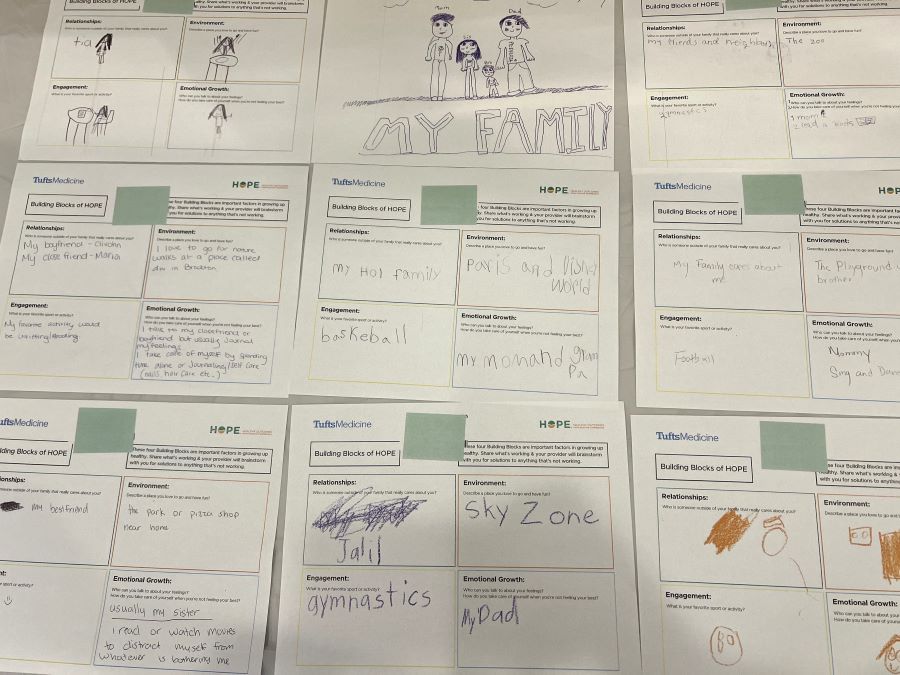
Key findings
- The HOPE framework aligned with the Tufts Medicine Pediatric Primary Care – Boston’s pre-existing culture and practices, making it easier for their staff to see the value and implementation of HOPE.
- The clinic started with short-term, practical, and achievable goals towards HOPE implementation, helping the organization build momentum and excitement toward longer-term HOPE improvements.
- The implementation of the HOPE framework takes time, intention, and shared accountability across the clinic.
Partner
Tufts Medicine Pediatric Primary Care – Boston
Challenge
Like many health institutions during and after the COVID-19 pandemic, Tufts Medicine Pediatric Primary Care – Boston faced significant challenges, including the closure of some patient units and the departure of many specialists.
Solution
In response to this challenge, Tufts Pediatrics prioritized programmatic efforts to build resilience among staff and families and strengthened its commitment to fostering a patient- and family-centered culture. The clinic implemented the HOPE framework through the HOPE-Informed Organizational Certification program and created meaningful improvements to their staff support and development, physical spaces, and policy updates.
Self-assessment
As part of the HOPE-Informed Organizational Certification program, Tufts Pediatrics completed a self-assessment using the Six Standards of HOPE to determine their organization’s current alignment with the HOPE framework. For their initial HOPE implementation, they focused on two standards:
- Knowledge of the HOPE framework: The clinic prioritized building their staff’s knowledge of HOPE, the Four Building Blocks of HOPE, and positive childhood experiences (PCEs).
- Supporting family strengths and resilience: The clinic applied their knowledge of HOPE to improve the patient experience including practical changes to their practice, processes, policies, and physical environment.
Key changes
Tufts Pediatrics transformed its self-assessment into actionable changes:
Staff support and development
The organization trained their staff on the HOPE framework including Introduction to HOPE workshops and follow-up refreshers. HOPE trainings were also integrated into the staff onboarding process, and HOPE-specific questions were added to annual reviews.
Physical space improvements
Tufts Pediatrics wanted to make its waiting area more welcoming for its patients and to connect more children and families to the Four Building Blocks of HOPE. Changes included:
- Repainting the walls to brighten up the space
- Featuring murals by local artists that welcomed patients in different languages
- Featuring artwork by local artists inspired by the Four Building Blocks of HOPE
- Installing a community resource corner that included clothing, books, and resource pamphlets in different languages
Blocking Blocks worksheet activity
The organization piloted a worksheet activity based on the Four Building Blocks of HOPE. The worksheet asks children to draw or describe how they see each Building Block. This exercise serves as a conversation starter for providers about what the child does to stay healthy and to brainstorm together on areas that may need attention. Copies of the worksheet were placed in the waiting room for children to complete while waiting to be seen.
Late policy updates
Tufts Pediatrics recognized that the original language of its late policy was too disciplinary. They updated the policy to be more understanding and accommodating to families’ needs.
Impact
Based on interviews, parents whose families received care at Tufts Pediatrics shared that they consistently had positive experiences at the clinic. The staff showed genuine concern and compassion that made parents feel seen and heard. The updated waiting room made families feel more comfortable and welcomed while waiting to be seen.
Staff members felt that they built stronger trust and transparency with their patients and empowered families to have a say in their care. They shared that integrating HOPE practices helped them prevent burnout and find fulfillment in their work.
Leadership at Tufts Pediatrics noted that HOPE helped energize and motivate their staff. The organization saw HOPE as not another thing to add to their workload but a natural extension and amplification of their work with families. This helped with the buy-in and onboarding process of HOPE implementation.
What’s next?
Tufts Pediatrics remains committed to using HOPE as a framework for supporting a compassionate, patient-centered space that promotes the well-being of its patients and staff. They plan to build upon their initial success with more targeted patient-centered improvements including updating additional policies and incorporating HOPE-inspired art in the exam rooms. The clinic is also beginning to define specific organizational outcomes, goals, and measures of success related to HOPE.
About the Partner

Tufts Medicine Pediatric Primary Care in partnership with Boston Children offers services for all ages, from babies to young adults and everyone in between. They provide the care that families need, whether it’s for regular checkups or diagnosing illnesses. Their Boston-based clinic is located on the main campus of Tufts Medical Center.
This case study was developed in partnership with Root Cause.






